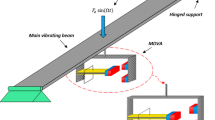Abstract
Background
Viscoelastic oscillator (VEO) is the basic element for viscoelastic damping structures and displays intermediate mechanical properties between purely Newton damping and purely Hooke spring. The modeling and prediction of the dynamic response of VEO are a challenging research task. Recently, fractional calculus is well used to model VEO and, however, fails to taking account into geometric factor by modeling the VEO as a rheological model.
Objective
Our objective was to establish a fractional Maxwell model of VEO (MFVEO) considering the geometric elements and derive its frequency response.
Method
The system equation of MFVEO was established by substituting the vibration equation and the geometric relation into the fractional Maxwell constitutive equation. The amplitude frequency function (AFF) and phase frequency function (PFF) of MFVEO were deduced by Laplace transform of fractional derivative as well as the linear and superposition properties. Finally, the variations of frequency responses of MFVEO under different system parameters were numerically studied.
Results
The system parameters, namely natural frequency, fractional orders, geometric factor and damping ratio, exert considerable effects on PFF and AFF of MFVEO at the specific frequency ratio. In addition, the harmonic peak exists for AFF and the corner frequency exists for PFF.
Conclusions
These results indicate that the frequency response of MFVEO is under influence of multiple factors and fractional orders; geometric factor should be optimized and designed for engineering applications.




Similar content being viewed by others
References
Shen Y, Yang S, Xing H, Ma H (2015) Design of single degree-of-freedom optimally passive vibration isolation system. J Vib Eng Technol 3:25–36
Rao MD (2003) Recent applications of viscoelastic damping for noise control in automobiles and commercial airplanes. J Sound Vib 3:457–474
Gattulli V, Potenza F, Lepidi M (2013) Damping performance of two simple oscillators coupled by a visco-elastic connection. J Sound Vib 26:6934–6948
Lei Y, Adhikari S, Friswell MI (2013) Vibration of nonlocal Kelvin–Voigt viscoelastic damped Timoshenko beams. Int J Eng Sci 66:1–13
Lim CW, Wu BS (2003) Accurate approximate analytical solutions to nonlinear oscillating systems with a non-rational restoring force. Adv Vib Eng 2:381–389
Schmidt A, Gaul L (2006) On a critique of a numerical scheme for the calculation of fractionally damped dynamical systems. Mech Res Commun 1:99–107
Schmidt A, Gaul L (2006) On the numerical evaluation of fractional derivatives in multi-degree-of-freedom systems. Signal Process 10:2592–2601
Vázquez L, Jafari H (2013) Fractional calculus: theory and numerical methods. Cent Eur J Phys 11:1163
Rossikhin YA, Shitikova MV (1997) Applications of fractional calculus to dynamic problems of linear and nonlinear hereditary mechanics of solids. Appl Mech Rev 1:15–67
Butera S, Paola MD (2014) Fractional differential equations solved by using Mellin transform. Commun Nonlinear Sci Numer Simul 19:2220–2227
Butera S, Paola MD (2015) Mellin transform approach for the solution of coupled systems of fractional differential equations. Commun Nonlinear Sci Numer Simul 20:32–38
Lewandowski R, Łasecka-Plura M (2016) Design sensitivity analysis of structures with viscoelastic dampers. Comput Struct 164:95–107
Spasic DT, Kovincic NI, Dankuc DV (2016) A new material identification pattern for the fractional Kelvin–Zener model describing biomaterials and human tissues. Commun Nonlinear Sci Numer Simul 37:193–199
Mondal PD, Ghosh A, Chakraborty S (2014) Control of underground blast induced vibration of structures using fluid viscous damper. J Vib Eng Technol 2:27–33
Lewandowski R, Chorążyczewski B (2010) Identification of the parameters of the Kelvin–Voigt and the Maxwell fractional models, used to modeling of viscoelastic dampers. Comput Struct 88:1–17
Li ZL, Sun DG, Han BH (2017) Response of viscoelastic damping system modeled by fractional viscoelastic oscillator. Proc IMechE Part C J Mech Eng Sci 231:3169–3180
Beltran-Carbajal F, Silva-Navarro G, Vazquez-Gonzalez B (2016) Multi-frequency harmonic vibration suppression on mass–spring–damper systems using active vibration absorbers. J Vib Eng Technol 4:1–12
Acknowledgements
The work described in this paper was fully supported by the National Natural Science Foundation for Young Scientists of China (Grant Nos. 51305288 and 51405323) and the Taiyuan University of Science and Technology Foundation for Doctor (Grant Nos. 20162035 and 20122050).
Author information
Authors and Affiliations
Corresponding author
Rights and permissions
About this article
Cite this article
Li, ZL., Liu, Zq., Sun, DG. et al. Fractional Maxwell Model of Viscoelastic Oscillator and Its Frequency Response. J. Vib. Eng. Technol. 6, 1–6 (2018). https://doi.org/10.1007/s42417-018-0005-8
Received:
Revised:
Accepted:
Published:
Issue Date:
DOI: https://doi.org/10.1007/s42417-018-0005-8




